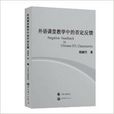《外語課堂教學中的否定反饋(英文)》就語言錯誤的定義、分類、成因以及否定反饋的必要性、作用和決定因素等問題進行了探討,採用定量分析和定性分析相結合的方法,對我國外語學習環境中高校教師提供否定反饋的情況進行了廣泛深入的調查分析,併科學運用了注意假設、語言發展階段假設、輸入說、輸出說、技能習得等二語習得理論對否定反饋現象和語言學習過程進行了剖析。
基本介紹
- 書名:外語課堂教學中的否定反饋
- 作者:胡越竹
- 出版日期:2013年6月1日
- 語種:簡體中文, 英語
- ISBN:7510056098, 9787510056093
- 外文名:Negative Feedback in Chinese EFL Classrooms
- 出版社:上海世界圖書出版公司
- 頁數:160頁
- 開本:32
- 品牌:上海世界圖書
基本介紹,內容簡介,作者簡介,圖書目錄,
基本介紹
內容簡介
《外語課堂教學中的否定反饋(英文)》體例新穎,是在作者的博士論文基礎上修訂而成的,內容涉及面更廣、更深入,研究設計更新、更全面,統計數據分析更透徹,具有創新性,對改進外語教學具有很好的指導作用。
作者簡介
胡越竹,女,上海外國語大學英語教師,英語語言文學博士,研究方向是二語習得,主持、參與了兩項上海外國語大學科研項目,在《江蘇外語教學研究》、《外語教學理論與實踐》等刊物上發表過多篇論文,主編、參與了多本教材,包括兩本普通高等教育“一十五”國家級規劃教材。
圖書目錄
摘要
Abstract
Chapter TwoErrors
2.1Defmition oferrors
2.2Attitude towards errors
2.3Evaluation oferrors
2.5Judgment of error gravity
2.6Causesoferrors
2.6.1Errors of competence
2.6.1.3Misconception-inducing teaching
2.6.1.4 Use of communication strategies
2.6.2Errors of performance
2.6.2.1Cognitive restrictions
2.6.2.2Psychologicalrestrictions
Chapter ThreeProvision of negative feedback
3.1Negative feedback
3.2Necessity and effect ofnegative feedback
3.3Factors taken into consideration in providing negative feedback
3.3.1Purpose ofthe activity
3.3.2Degree ofdeviation
3.3.3Clarity ofmeaning
3.3.4Frequencyofoccurrence
3.3.5Leamers'language proficiency
3.3.6Affectivefactors
3.3.7Personalityoflearners
3.3.8Otherfactors
3.4Empirical studies on provision of negative feedback
3.4.1How often errors were treated
3.4.2What types of errors were treated
3.4.3How errors were treated
3.4.4When errors were treated
3.4.5Who corrected errors
Chapter Four Negative feedback in EFL classrooms
4.1Purpose ofthe research
4.2 Methodology
4.2.1Subjects
4.2.2Instruments
4.2.2.1Questionnaires
4.2.2.2Interviews
4.2.3Datacollection
4.2.4 Dataanalysis
4.2.4.1Teachers' and students' response to the questionnaires
4.2.4.2Transcription of the interview
4.3Results and discussion
4.3.1How often errors were treated
4.3.1.1Teachers' opinion and corrective behavior
4.3.1.2Students' needs and preferences
4.3.1.3Discussion
4.3.2What types of errors were treated
4.3.2.1Teacher's opinion and corrective behavior
4.3.2.2Students, needs and preferences
4.3.2.3Discussion
4.3.3How errors were treated
4.3.3.1Teachers' opinions and corrective behavior
4.3.3.2Students'needs andpreferences
4.3.3.3Discussion
ChapterFive Conclusion
5.1Major findings
5.2Pedagogicalimplications
5.3Limitations ofthe study
References
Appendix Ⅰ
Appendix Ⅱ
Appendix Ⅲ
Appendix Ⅳ
Abstract
Chapter TwoErrors
2.1Defmition oferrors
2.2Attitude towards errors
2.3Evaluation oferrors
2.5Judgment of error gravity
2.6Causesoferrors
2.6.1Errors of competence
2.6.1.3Misconception-inducing teaching
2.6.1.4 Use of communication strategies
2.6.2Errors of performance
2.6.2.1Cognitive restrictions
2.6.2.2Psychologicalrestrictions
Chapter ThreeProvision of negative feedback
3.1Negative feedback
3.2Necessity and effect ofnegative feedback
3.3Factors taken into consideration in providing negative feedback
3.3.1Purpose ofthe activity
3.3.2Degree ofdeviation
3.3.3Clarity ofmeaning
3.3.4Frequencyofoccurrence
3.3.5Leamers'language proficiency
3.3.6Affectivefactors
3.3.7Personalityoflearners
3.3.8Otherfactors
3.4Empirical studies on provision of negative feedback
3.4.1How often errors were treated
3.4.2What types of errors were treated
3.4.3How errors were treated
3.4.4When errors were treated
3.4.5Who corrected errors
Chapter Four Negative feedback in EFL classrooms
4.1Purpose ofthe research
4.2 Methodology
4.2.1Subjects
4.2.2Instruments
4.2.2.1Questionnaires
4.2.2.2Interviews
4.2.3Datacollection
4.2.4 Dataanalysis
4.2.4.1Teachers' and students' response to the questionnaires
4.2.4.2Transcription of the interview
4.3Results and discussion
4.3.1How often errors were treated
4.3.1.1Teachers' opinion and corrective behavior
4.3.1.2Students' needs and preferences
4.3.1.3Discussion
4.3.2What types of errors were treated
4.3.2.1Teacher's opinion and corrective behavior
4.3.2.2Students, needs and preferences
4.3.2.3Discussion
4.3.3How errors were treated
4.3.3.1Teachers' opinions and corrective behavior
4.3.3.2Students'needs andpreferences
4.3.3.3Discussion
ChapterFive Conclusion
5.1Major findings
5.2Pedagogicalimplications
5.3Limitations ofthe study
References
Appendix Ⅰ
Appendix Ⅱ
Appendix Ⅲ
Appendix Ⅳ

